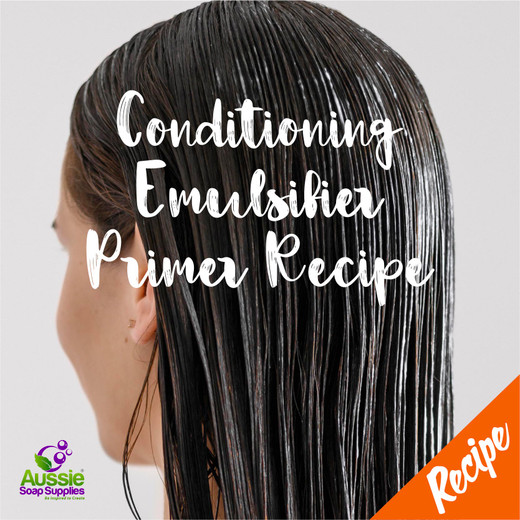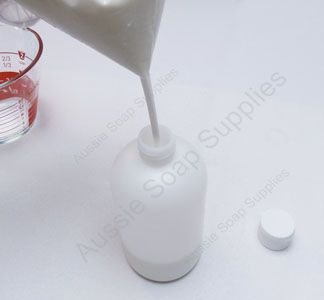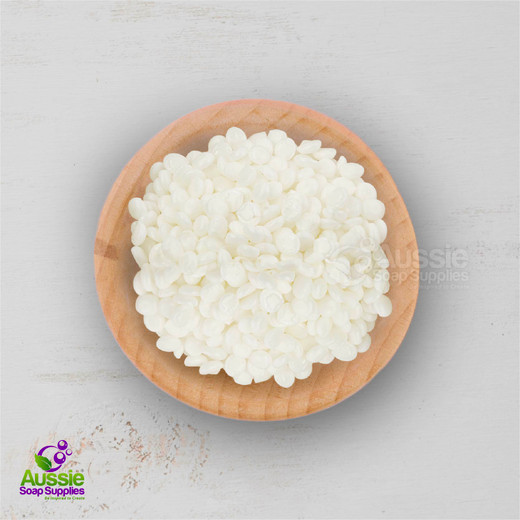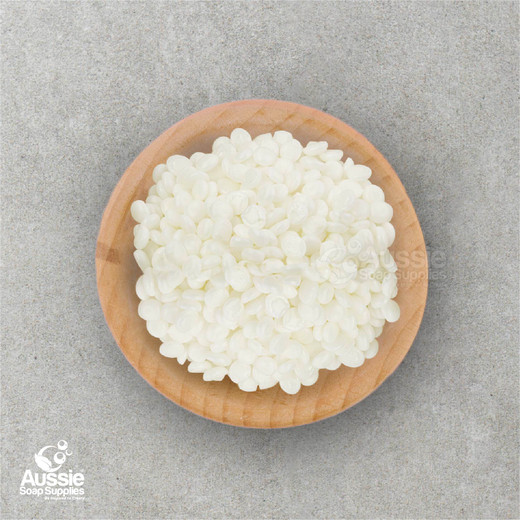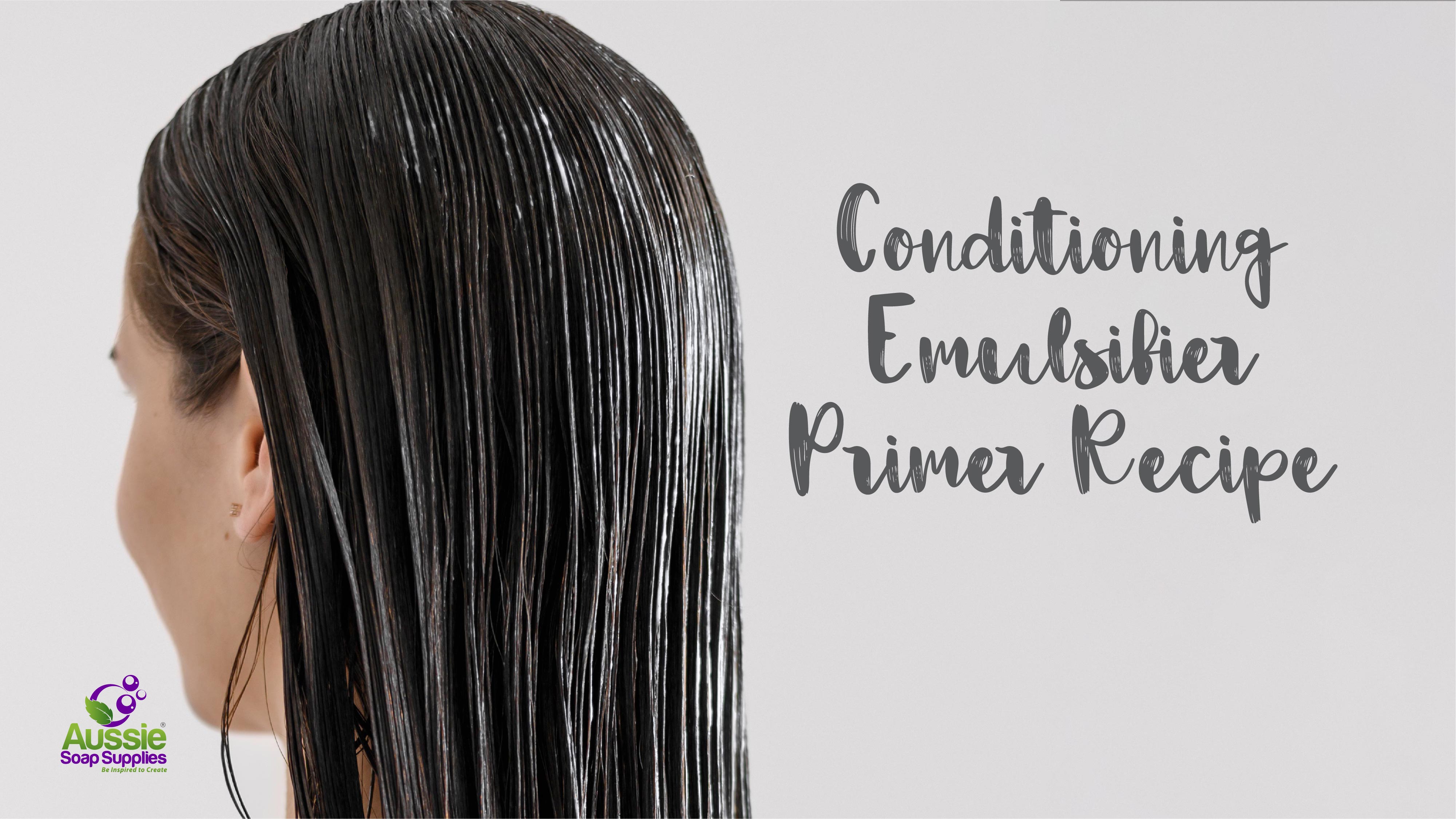
[We are very proud to be the first in Australia to introduce this amazing ingredient to you. We have put in a lot of time and effort in order to understand this emulsifier, and to further our knowledge (and yours). We thank Morgan Faie for her help and contributions back in 2004 - her recipes are on a separate page.]
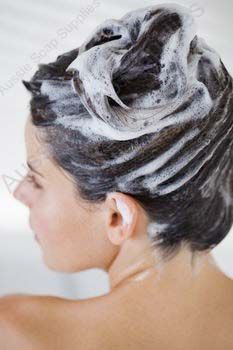
Our Conditioning Emulsifiers are a combination of a conditioning quaternary ammonium compound which is derived from Canola Oil (Non GMO natural Colza) and Cetearyl, a fatty alcohol.
Conditioning Emulsifiers behaves in the same manner as Emulsifying Wax NF in as much as it is a self emulsifying compound that can be used to make an oil in water emulsion. The inclusion of the quaternary compound is the reason why it is used as a Hair and Skin conditioner.
The amazing thing with Conditioning Emulsifier is that you can literally combine the pastilles with water and you have created an extremely gentle, every day hair conditioner - there is no need to add anything else. However, because it is an emulsifier you can add other emollients and ingredients to create your own incredible, salon quality hair conditioners at home. Conditioning Emulsifier will give your home-formulated conditioners lubricity and static control, offering excellent wet combing and detangling. From the basic formulation, you can then start to build your own specialized hair conditioners by including
Hydrolyzed Proteins,
Herbal Extracts,
dl Panthenol
and small amounts of Fixed Oils (such as Jojoba or Coconut Oil) to make a really fabulous hair conditioner. By choosing which ingredients you add, you can tailor your conditioner to suit your own hair.
Conditioning Emulsifiers comes in pastille form, are vegetable derived and not tested on animals making them suitable for Vegans, Vegetarians and those requiring cruelty free ingredients. Conditioning Emulsifiers are also excellent at emulsifying difficult to include ingredients, such as Silicones. Dimethicone and Cyclomethicone can be difficult to incorporate into emulsions (and silicone substitute Silc-Oliv which is easier to combine) are all easily emulsified. It is however, NOT SUITABLE for use with Veg Emulse as these two ingredients are not compatible. I have however successfully blended a Night Eye Cream with these two with a little perseverance and determination to break the chemistry! This is because Veg-Emulse is not compatible with cationic ingredients, and it is this 'quat' that does its magic in your hair.
If you wish to avoid silicones, you can substitute our Silc-Oliv which will give similar results but is entirely silicone free.
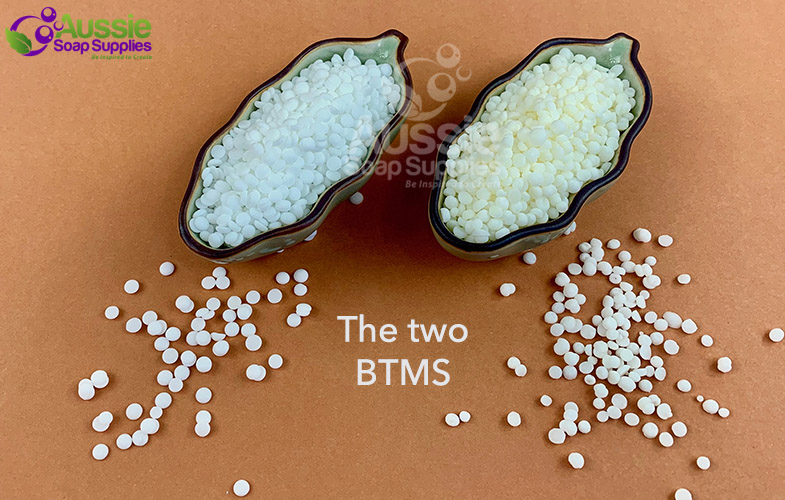
BTMS 25 vs BTMS 50
You will often see Conditioning Emulsifier 25 and Conditioning Emulsifier 50 referred to as BTMS 25 vs BTMS 50. This is because they are both so similar and the BTMS refers to their proper or "INCI" names - the initials anyway! The numbers! If the numbers are new to you, these refer to the active conditioning ingredient in each one.
Conditioning Emulsifier 50 (BTMS 50) is a combination of a conditioning compound, which is derived from the natural plant oil Colza (Canola), and a fatty alcohol (Cetearyl Alcohol) plus the addition of Butylene Glycol which imparts extra moisture and emolliency to our product.
Conditioning Emulsifier 25 (BTMS 25) is a combination of a conditioning compound, which is derived from the natural plant oil Colza (Canola), and a fatty alcohol (Cetearyl Alcohol).
So if you tend to have dry hair, you may find this is a BTMS 50 a better ingredient for your Hair Conditioners - you have double the active 'quat' and the extra Butylene Glycol which means it is also more helpful for dry hair as the latter adds emollience and moisture.
If your hair is more oily, try the BTMS 25 first!
See THIS page for our suggestions of the best fragrances for hair products
SCROLL DOWN TO SEE THE BEGINNER RECIPES
- Basic Hair Conditioner
- Creamy Avocado Hair Conditioner
- Basic Conditioner with Protein & dl Panthenol
NB: A note on the percentage formulation with regards to preservative and Essential Oil or Fragrance usage: In order to have the formulation equal exactly 100%, we are taking into account that some people will use minimal preservative and some will like a heavily fragranced product, and others prefer a subtle scent, there is room to adjust the percentages within these formulations - just ensure you adjust the amount of water accordingly.

Basic Hair Conditioner
For anyone formulating their own hair conditioner for the first time, I recommend starting with this recipe. By trying the basic Conditioning Emulsifier and water formulation this gives you a really good idea of what the product behaves like before adding any other emollients or ingredients. Also, at usage rate of 5% it is very inexpensive, and will give you an end product that rivals any supermarket bought product.
This formula makes 200g - to increase the volume use the percentage amounts to keep your formulation in balance.
Phase A
10g Conditioning Emulsifier 25 (5%)
185g Distilled Water (90% - adjust as necessary to make formulation to 100%)
Phase B
1 - 2g Preservative (0.5 - 1%)
2 - 5g Essential Oils and/or Fragrance (1-3%)
Method
- Combine Phase A ingredients and heat to 80°C whilst stirring.
- When homogeneous take off the heat and stir periodically while cooling.
- Then add the required percentage of preservative for the brand you are using at the recommended temperature (which is generally 0.5 - 1% added at around 40°C) mix well to combine.
- Lastly, add any essential oils or fragrance that you wish to, mixing well to combine.
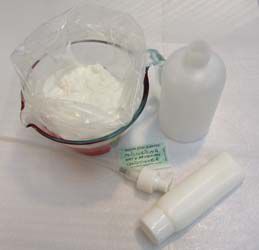
Basic Hair Conditioner with Protein & dl Panthenol
After making the initial formulation, try including some protein and Pro Vitamin B5. This formulation starts to incorporate the natural benefits of the oils we all love to include in our lotions and creams. Jojoba Oil, Wheatgerm Oil, Hempseed Oil. Any or all of these can be combined by themselves or in a combination to impart different qualities to your conditioner. Typically heavier oils are better for thicker or drier hair, and lighter oils are better for fine and oily hair types. You can further tailor your formulation with the inclusion of Essential Oils suited for your chosen hair type.
This formula makes 200g - to increase the volume use the percentage amounts to keep your formulation in balance.
Phase A
10g Conditioning Emulsifier 25 (5%)
180g Distilled Water (90% - adjust as necessary to make formulation to 100%)
Phase B
3g Hydrolyzed Wheat or Hydrolyzed Oats (1.5%)
3g dl Panthenol (1.5%)
Phase C
3g Preservative (0.75%)
1g Essential Oils or Fragrance (0.25%)
Method
- Heat Phase A to 75°C (cover the container to avoid evaporation).
- Add the hydrolyzed proteins and dl Panthenol to the hot water and stir.
- Stir intermittently during the cooling time until temperature is approximately 40°C.
- Now add Phase C ingredients and mix well until completely combined.
- Bottle them into Malibu or Tottle Tubes or Stubby Shampoo Bottles and seal when cold.
Creamy Avocado Hair Conditioner
This is a little more complicated, but still easy to make - and is a gorgeous creamy, thick consistency as we use a combination of emulsifiers. If you prefer to use another oil, rather than Avocado, it works really well using Hemp seed or Coconut Oils too.
This recipe makes 400g.
Phase A
345g Distilled Water or Floral Water (86.5%)
1g Guar Conditioner (0.25%)
Phase B
4g Emulsifying Wax NF (1%)
18g Conditioning Emulsifier 25 (4.5%)
4g Cetyl Stearyl Alcohol (1%)
4g Vitamin E (1%)
15g Avocado Oil (3.75%)
Phase C
4g Hydrolyzed Wheat or Hydrolyzed Oats (1%)
Phase D
3g Phenoserve (0.75%)
1g Essential Oils or Fragrance (0.25%) - I really like Energy in this formulation
Method:
- Heat Phase A (Distilled Water) to 75°C (Cover the container to avoid evaporation).
- Add the Guar to the hot water. The Guar Conditioner needs to be hydrated, so stir well (I give it a blast with my stick blender. Allow this to rest, covered for 60 minutes.
- Now add the hydrolyzed protein.
- Check the temperature and gently reheat to 75°C.
- Now heat Phase B ingredients in a separate jug until fully liquid and around 75°C.
- Ensure both Phases are at 70 - 75°C and then combine Phase A and B and stir to combine. The mixture will immediately become creamy and only needs a hand stir, or a few pulses of a stick blender, and then hand whisking.
- Allow to cool to approximately 40° C, stirring occasionally during the cooling time.
- Now add the Fragrance or Essential Oils and the Phenoserve (Preservative).
- Bottle into Malibu or Tottle Tubes or Stubby Shampoo Bottles and seal when cold.
This page and all recipes and content are copyright ©Aussie Soap Supplies™ and may not be reproduced in any form without written permission by the author.


